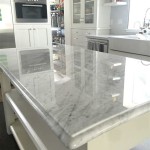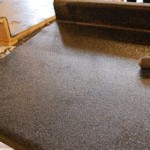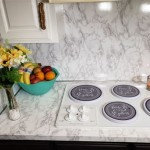How To Remove Caulk From Countertop
Caulk, a flexible sealant, is commonly used to create a watertight barrier between countertops and backsplashes, sinks, or other surfaces. Over time, caulk can deteriorate, becoming discolored, cracked, or moldy. When this occurs, it’s necessary to remove the old caulk and reapply a fresh bead to maintain a clean and sanitary environment. This article provides a detailed guide on how to effectively remove caulk from countertops without damaging the underlying surface.
Before embarking on the removal process, gather the necessary tools and materials. The right tools will not only make the job easier but also minimize the risk of scratching or otherwise harming the countertop. The following items are typically required:
- Utility knife or specialized caulk removal tool
- Plastic putty knife or scraper
- Heat gun or hairdryer (optional)
- Caulk softener or solvent (optional)
- Household cleaner or degreaser
- Clean cloths or paper towels
- Safety glasses
- Gloves
Safety is paramount when dealing with sharp tools and potentially harsh chemicals. Always wear safety glasses to protect the eyes from debris and gloves to protect the skin from irritants. Ensure adequate ventilation in the work area, especially if using solvents. By taking these precautions, you can safely and effectively remove the old caulk and prepare the countertop for resealing.
Key Point 1: Preparing for Caulk Removal
Proper preparation is crucial for a successful caulk removal process. This involves inspecting the existing caulk, softening it if necessary, and protecting the surrounding areas.
First, thoroughly inspect the caulk to determine the extent of the damage and the type of caulk used. Silicone caulk is generally more flexible and easier to remove than acrylic caulk, which tends to be more rigid. Note any areas where the caulk is particularly thick or deeply embedded. This assessment will inform the chosen removal method and the amount of effort required.
Next, consider softening the caulk to make it more pliable and easier to cut. This is particularly helpful for older, hardened caulk. A heat gun or hairdryer can be used to gently warm the caulk, softening its adhesive bond. Apply heat in short bursts, moving the heat source back and forth to avoid overheating or damaging the countertop. Alternatively, a commercial caulk softener or solvent can be applied to the caulk bead. Follow the manufacturer's instructions carefully, and allow the softener to penetrate the caulk for the recommended time before attempting removal. Be cautious when using solvents, ensuring adequate ventilation and avoiding contact with skin and eyes.
Before beginning the removal process, protect the countertop surface adjacent to the caulk line. Use painter's tape to mask off the areas directly beside the caulk. This will prevent scratches or abrasions from the removal tools. Pay particular attention to delicate surfaces, such as natural stone countertops, which are more prone to damage.
Finally, ensure the work area is clean and dry. Remove any debris or obstructions that might interfere with the removal process. A clean surface will also provide better visibility and control during the removal process.
Key Point 2: Removing the Old Caulk
The actual removal of the caulk requires a careful and methodical approach. The goal is to remove the caulk completely without damaging the countertop surface. Several tools and techniques can be employed, depending on the type and condition of the caulk.
Begin by carefully slicing through the caulk bead using a utility knife or specialized caulk removal tool. Hold the knife at a shallow angle and run it along both edges of the caulk line, where it meets the countertop and the backsplash or sink. Applying consistent pressure and maintaining a steady hand will result in a clean, even cut. For thick caulk beads, it may be necessary to make multiple passes with the knife.
Once the caulk is scored, use a plastic putty knife or scraper to gently pry the caulk away from the countertop. Start at one end of the caulk line and work your way along, applying steady pressure. Avoid using metal scrapers, as they are more likely to scratch the countertop surface. If the caulk is resistant to removal, try applying more heat or caulk softener.
For stubborn areas, a specialized caulk removal tool can be particularly effective. These tools are designed with angled blades that can reach into tight spaces and remove caulk with minimal effort. Follow the manufacturer's instructions for proper use of the tool.
As the caulk is removed, peel it away in sections. Dispose of the old caulk properly. Avoid simply discarding it into the sink or garbage disposal, as it can clog drains. Place the removed caulk in a plastic bag and dispose of it in the trash.
After removing the bulk of the caulk, there may be residual residue remaining on the countertop surface. This residue can be difficult to remove with scraping alone. A combination of solvents and gentle scrubbing may be necessary. Apply a small amount of mineral spirits or denatured alcohol to a clean cloth and gently rub the affected area. Avoid using harsh chemicals or abrasive cleaners, as they can damage the countertop finish.
Repeat the process of applying solvent and scrubbing until all traces of the old caulk have been removed. Inspect the surface carefully to ensure that no residue remains. A clean, smooth surface is essential for proper adhesion of the new caulk.
Key Point 3: Cleaning and Preparing the Surface for New Caulk
With the old caulk removed, the final step is to thoroughly clean and prepare the countertop surface for the application of new caulk. This step is critical for ensuring a strong and long-lasting seal.
First, clean the area with a household cleaner or degreaser to remove any remaining dirt, grease, or soap scum. Pay particular attention to areas where mold or mildew may have been present. Use a scrub brush or sponge to thoroughly clean the surface, and then rinse with clean water. Allow the surface to dry completely before proceeding.
Inspect the countertop for any damage, such as chips or cracks, that may need to be repaired. Small imperfections can be filled with epoxy or other suitable repair material. Follow the manufacturer's instructions for proper application and curing of the repair material. A smooth, even surface is essential for a watertight seal.
Before applying new caulk, it is important to ensure that the surface is completely dry. Moisture can interfere with the adhesion of the caulk and lead to premature failure. Use a clean, dry cloth to wipe the area thoroughly. If necessary, use a hairdryer on a low setting to expedite the drying process. Avoid using excessive heat, as it can damage certain countertop materials.
Finally, apply a fresh bead of painter's tape along the edges of the countertop and backsplash or sink, creating a consistent and clean line for the new caulk. This will help to prevent smudging and ensure a professional-looking finish. Ensure that the tape is firmly adhered to the surface to prevent caulk from seeping underneath.
Once the surface is clean, dry, and properly taped, it is ready for the application of new caulk. Choose a caulk that is appropriate for the material of the countertop and the intended use. Silicone caulk is generally recommended for areas that are exposed to moisture, such as around sinks and bathtubs. Acrylic caulk is a good choice for areas that are not exposed to water. Follow the manufacturer's instructions for proper application of the caulk. Apply a consistent bead of caulk along the joint, and then smooth it with a wet finger or a specialized caulk smoothing tool. Remove the painter's tape before the caulk dries completely, and then allow the caulk to cure fully before exposing it to water or other liquids.
By following these steps, you can effectively remove old caulk from a countertop and prepare the surface for a new, watertight seal. Proper preparation, careful removal techniques, and thorough cleaning are essential for achieving a successful and long-lasting result.

How To Replace Caulk On A Kitchen Tile Backsplash Countertop

Quartz Countertop Caulking Removal And Replacement

How To Replace Grout With Caulk On A Kitchen Tile Backsplash Caulking Countertop Youtube

Easily Remove Silicone Caulk Without Chemicals

How To Remove Old Caulk Dap Global

Easy Way To Clean Moldy Caulk And Keep It That Checking In With Chelsea

How To Caulk A Kitchen Counter With Easy Steps Faqs And Abbotts At Home

Easy Way To Clean Moldy Caulk And Keep It That Checking In With Chelsea

Easy How To Replace The Silicone On An Undercounter Sink Youtube

Easy Way To Clean Moldy Caulk And Keep It That Checking In With Chelsea
See Also








